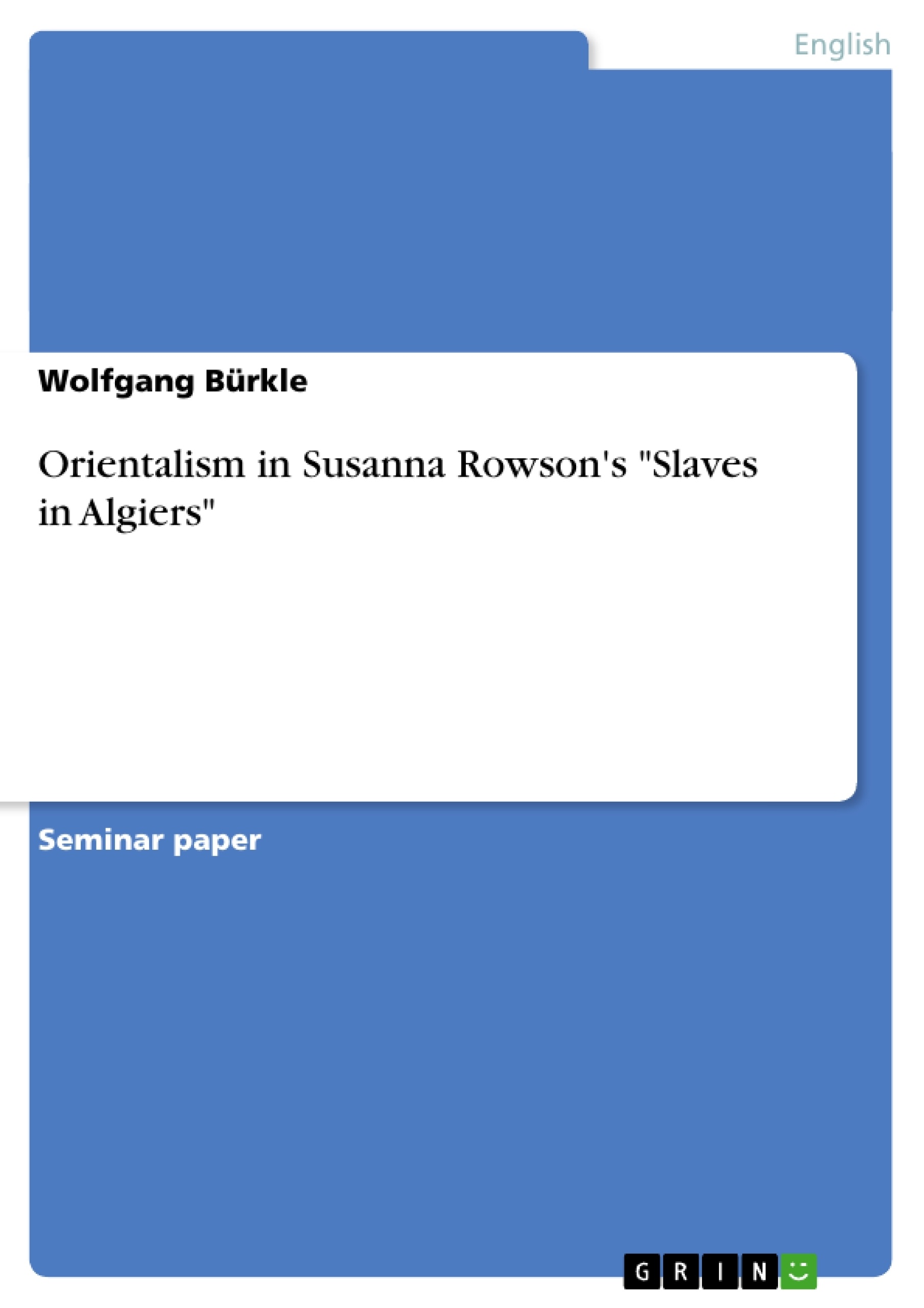When Susanna Haswell Rowson wrote her play “Slaves in Algiers” in 1794, many people in America and Europe were fascinated by stories about the Orient. The exotic tales from faraway countries with strange animals, hot deserts, magnificent palaces, and captured sailors attracted many readers. It did not matter if the described events were true or not, as long as they provided an exciting story with Oriental scenery. Writers then created their own picture of the Orient, often with exaggerating fantasy. The interesting aspect of Rowson’s play is therefore her view of the Oriental people and their culture in contrast to the American people and their culture. She creates a specific picture of the Arabic culture and its people to show the advantages of the American values. It is also notable how she describes the difference of the sexes and their struggle for liberty in a foreign land. Rowson describes in “Slaves in Algiers”, with the help of the characters, her opinions on liberty, emancipation, and white slavery in the Orient. Rowson’s description of the Orient and the Arabic culture in the drama is her device to show the superiority of American values and the importance of liberty in every society. The historical context and the definition of Orientalism serve as a basis to understand her opinions.
Inhaltsverzeichnis (Table of Contents)
- Introduction
- Historical Context
- White Slavery
- "Slaves in Algiers"
- Orientalism
- Oriental Architecture and Symbols in “Slaves in Algiers”
- Characters and Stereotypes
- The Dey
- The Oriental People
- Ben Hassan and the Veil
- Liberty
- Gender Relationship
Zielsetzung und Themenschwerpunkte (Objectives and Key Themes)
This research paper aims to analyze Susanna Haswell Rowson's play "Slaves in Algiers" through the lens of Orientalism. It examines Rowson's depiction of the Orient and the Arabic culture as a means to showcase the superiority of American values and the importance of liberty. The paper explores the historical context surrounding white slavery in the Barbary States and uses the concept of Orientalism to understand Rowson's portrayal of the Orient.
- Orientalism and its role in shaping perceptions of the Orient
- White slavery in the Barbary States and its impact on American society
- The portrayal of the Arabic culture and its people in "Slaves in Algiers"
- The themes of liberty, emancipation, and gender relationships within the play
- Rowson's use of the play to promote American values and ideals
Zusammenfassung der Kapitel (Chapter Summaries)
- Introduction: This chapter introduces the research topic and provides an overview of the play "Slaves in Algiers". It highlights Rowson's focus on Orientalism and its connection to American values and liberty.
- Historical Context: This chapter delves into the historical background of the Barbary States and the practice of white slavery. It explains the context of the American-Algerian War and the significance of captivity narratives in the 18th century.
- White Slavery: This chapter explores the nature of white slavery in the Barbary States, contrasting it with slavery in the United States. It examines the conditions of the captives, their experiences, and the role of ransom in their release.
- "Slaves in Algiers": This chapter introduces the play and one of its main characters, Rebecca. It highlights Rebecca's role in "civilizing" the Oriental women by teaching them about liberty.
- Orientalism: This chapter focuses on the concept of Orientalism and its influence on Rowson's portrayal of the Orient. It discusses the exoticism and stereotypes associated with the Orient in the 18th century.
- Oriental Architecture and Symbols in "Slaves in Algiers": This chapter analyzes the use of architecture and symbols in the play to create an Oriental setting. It explores how these elements contribute to the depiction of the Arabic culture.
- Characters and Stereotypes: This chapter examines the various characters in the play, including the Dey, the Oriental people, and Ben Hassan. It analyzes the stereotypes associated with these characters and how they contribute to Rowson's portrayal of the Arabic culture.
- Liberty: This chapter discusses the theme of liberty in the play and how it is portrayed through the characters' experiences and actions. It explores the importance of liberty in Rowson's view of American values.
- Gender Relationship: This chapter examines the gender dynamics within the play and the roles of women in the Oriental society. It explores the themes of female agency and the struggle for liberation.
Schlüsselwörter (Keywords)
Key concepts and terms associated with the text include Orientalism, white slavery, captivity narratives, American values, liberty, emancipation, gender relationships, the Barbary States, the Arabic culture, and the play "Slaves in Algiers". These keywords highlight the research focus on exploring the intersection of historical context, cultural representations, and the themes of liberty and emancipation in Rowson's play.
- Arbeit zitieren
- Wolfgang Bürkle (Autor:in), 2005, Orientalism in Susanna Rowson's "Slaves in Algiers", München, GRIN Verlag, https://www.hausarbeiten.de/document/39622


